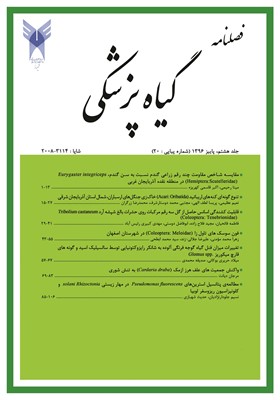مطالعهی پتانسیل استرینهایPseudomonas fluorescens در مهار زیستی solani Rhizoctonia و کلونیزاسیون ریزوسفر لوبیا
محورهای موضوعی : گیاه پزشکینسیم جلودارنژادیان 1 * , حدیث شهبازی 2
1 - گروه گیاه پزشکی، موسسه آموزش عالی غیرانتفاعی مهرگان، محلات، ایران
2 - گروه گیاهپزشکی، موسسه آموزش عالی غیرانتفاعی مهرگان، محلات، ایران
کلید واژه: biocontrol, damping off, بوتهمیری, کنترلبیولوژیک, اندوریزوسفر, اکتوریزوسفر, endorhizosphere, ectorhizosphere,
چکیده مقاله :
یکی از مهم ترین بیماریهای لوبیا، بیماری بوتهمیری ناشی از solaniRhizoctonia است که کنترلشیمیایی آن بهدلیل خاکزاد بودن و دامنهی میزبانی بالا ناکاراست. کاربرد عوامل بیوکنترل باکتریایی از راهکارهای امیدبخش در کنترل این بیماری است. در این تحقیق توانایی آنتاگونیستی هشت جدایهیPseudomonas fluorescens علیه R. solani بررسی و جدایهی P13 که در کنترل بیمارگر موفق تر بود جهت مطالعهی الگوی کلونیزاسیون ریشهی لوبیا مورد استفاده قرار گرفت. در این پژوهش توانایی بیوکنترل جدایه هایباکتری در مقابل جدایه ی R. solani با قدرت بیماریزایی بالاتر که از مزارع لوبیایآلوده در شهرستان خمین جمعآوری شده بود، توسط آزمون های کشتمتقابل، چهارنقطه ای، تولید ترکیباتفرار و غیرفرار بررسی و جدایه یP13 با بیشترین تاثیر در بازدارندگی از رشد بیمارگر برای ادامهی پژوهش انتخاب شد. پس از آن جمعیت باکتری در 45،30،15 روز پس از کاشت در اندوریزوسفر و اکتوریزوسفر ریشهی لوبیا اندازه گیری و تاثیر آن در میزان شدت بیماریزایی بیمارگر ،ارتفاع بوته، وزنخشک و تر گیاه اندازه گیری شد. پس از کاهش جمعیت اولیهی باکتری در ریزوسفر در روز پانزدهم، جمعیت باکتری در روزهای سی ام و چهلوپنجم در اندوریزوسفردر حال کاهش و در اکتوریزوسفر رشد صعودی داشت. در روز چهلوپنجم در اندوریزوسفر و اکتوریزوسفر بهترتیب در خاک سالم 105×2/3 و 107×1/1 (cfu/g fresh root) و در خاک آلوده به بیمارگر، 105×8/2 و 106×06/1 cfu/g fresh root)) سلول باکتری در وزنتر ریشه بازیابی شد. جمعیت بالایی از جدایهی P13 در روز چهل و پنجم از اندوریزوسفر و اکتوریزوسفر لوبیا باعث کاهش معنی دار شدت بیماری و افزایش پارامترهای رشدی گیاه شد. نتایج نشان داد جدایهیP13 P. fluorescens میتواند بهصورت معنی دار، از رشد R. solani جلوگیری کند.
Damping off caused by Rhizoctonia solani: is one of the most important diseases of beans. Some control methods have been applied to overcome it but none seemed to be satisfactory. Biological control has been explored as an additional or alternative means of managing R. solani damping off. In this study, biocontrol ability of 8 isolates of Pseudomonas fluorescens were evaluated against R. solani and potential of rhizosphere colonization of the selected isolate was investigated. In this study, pathogenic fungi were isolated from infected plants of common bean crop fields in Khomein. Fungal isolate with the most pathogenicity was selected. Growth inhibition of R. solani selected isolate was evaluated by dual culture test, the antifungal activity of bacterial volatile and nonvolatile metabolites and P13 strain which was capable to produce maximum inhibitory zone was selected for studying its ability to biocontrol of pathogen and colonization of the ectorhizosphere and endorhizosphere of bean in 15, 30 and 45 days after planting under greenhouse conditions. Although the initial population of bacteria decreased in rhizosphere in 15th day, the population of bacteria in days 30th and 45th days increased in ectorhizosphere and decreased in endorhizosphere. Population of P13 was in the endorhizosphere and ectorhizosphere, in the healthy soil pollution 3/2 × 105 and 1/1 × 107 Cfu/g (fresh weight of root) and in infected soil 2/8 × 105 and 1/06 × 106 Cfu/g (fresh weight of root), respectively. Results showed that the severity of R. solani was significantly decreased and plant growth parameters were increased by biocontrol bacterial density on rhizosphere. P13 with great population on ecto and endorhizosphere showed strong positive effect on plant growth and inhibition of R. solani in 45th days
_||_

